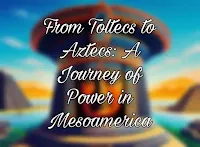How did the Toltecs and Aztecs rise to power?
How did the Toltecs and Aztecs rise to power?
The rise to power of both the Toltecs and Aztecs in Mesoamerica was marked by a combination of strategic alliances, military conquests, cultural assimilation, and political maneuvering. While they emerged at different times and in different regions, both civilizations left a significant impact on the history and culture of Central America.
Toltecs
1. Migration and Settlement:
The Toltecs originated from northern Mesoamerica and migrated southwards, settling in the region around present-day Tula, Hidalgo, Mexico. Their settlement established Tula as a major urban center.
2. Military Expansion:
Under the leadership of rulers like Mixcoatl and Ce Acatl Topiltzin, the Toltecs engaged in military conquests, expanding their territory and influence. They conquered neighboring city-states and established dominance over trade routes, gaining access to valuable resources.
3. Cultural Influence:
The Toltecs were renowned for their cultural achievements, including architecture, sculpture, and metallurgy. Their cultural influence extended throughout Mesoamerica, contributing to their prestige and power.
4. Political Consolidation:
Toltec rulers implemented centralized political systems, which allowed for effective governance and control over their growing territory. This political consolidation facilitated further expansion and stability within their realm.
Aztecs
1. Migration and Alliance:
The Aztecs, also known as Mexica, originated from the northern regions of Mesoamerica. They migrated southwards and eventually settled in the Valley of Mexico, where they formed an alliance with other Nahua city-states, including Texcoco and Tlacopan, to establish the Aztec Triple Alliance.
2. Military Conquests:
Through a series of military campaigns, the Aztecs expanded their influence over neighboring territories, subjugating rival city-states and extracting tribute from conquered peoples. Their military prowess and strategic alliances enabled them to become the dominant power in the region.
3. Religious and Cultural Practices:
The Aztecs adopted and adapted elements of the cultures they encountered, incorporating them into their own religious and cultural practices. This syncretism helped to unify diverse peoples under Aztec rule and reinforce their authority.
4. Political Organization:
The Aztecs developed a sophisticated political system with hierarchical social structures, centralized governance, and a complex tribute system. This allowed them to effectively govern their vast empire and maintain control over their subjects.
In summary, both the Toltecs and Aztecs rose to power through a combination of military conquests, cultural assimilation, political organization, and strategic alliances. Their legacies endure in the history and culture of Mesoamerica, shaping the civilizations that came after them.
